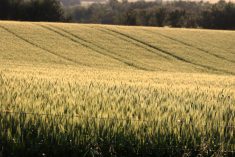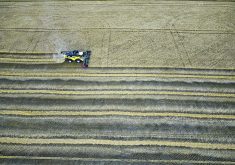Precipitation has impacted some regions and crops including malt barley that has experienced some chitting
Some Prairie grain producers had to deal with rain last week, but managed to make hay when the sun did shine.
Areas in southeastern Saskatchewan and southwestern Manitoba received the most moisture, with more than 40 millimetres in the Corning, Sask., area and more than 21-24 mm in Glenboro and Arborg areas of Manitoba.
Mitchell Japp, research and extension manager with SaskBarley, said barley harvest has been progressing for Saskatchewan producers with 68 per cent of barley crops off the field and areas in the southwest nearing completion.
Read Also

Saskatchewan throne speech promises strong economy
Saskatchewan’s legislative agenda for the coming year will focus on meeting the challenges of new world trading relationships, said the speech from the throne.
The rain has had an impact on some producers, especially with chitting in malt barley crops.
“They’re geared for rapid germination and as it gets to be mature in the field, it’s pretty sensitive to moisture.”
Every producer that Japp has spoken with has been happy with their yields, he said.
“It seems like even (in) those drier areas (yields) were a little bit higher than expected.”
Some regions of central and southern Alberta received nearly 40 mm of rain last week. But even with heavy precipitation in some areas, provincial averages for soil moisture saw little change as surface soil ratings in the good to excellent category saw an increase of only one percent from last week, while good to excellent sub-surface soil ratings decreased by two percent.
Manitoba saw similar ratings with dry conditions reported for most of the province in 0-30 centimetres soil moisture conditions. This is a drop from last week when the conditions were rated at optimal to dry. Soil conditions from 0-120 cm remain at optimal to dry with some areas of the southwest reporting wet conditions at this depth.
Soil moisture conditions in Saskatchewan also remain unchanged. Cropland was estimated at 36 percent adequate, 39 percent at short, and 25 percent at very short. The province’s hay and pasture land reports similar percentages at 29 percent adequate, 40 percent short, and 31 very short.
Recent crop reports from the prairie agriculture departments report favourable conditions for most farmers as they continue to get the 2023 crops into bins.
Northwest and northeast producers in Alberta face harvest challenges with wet and cool conditions causing delays in maturity, lodging and field access, according to the Sept. 5 Alberta crop report.
South, central, and Peace regions are all ahead of the historical average, which is causing a bump in the provincial averages.
Alberta’s harvest of all major crops nearly doubled from last week’s numbers, with nearly 31 percent off the field.
As of Sept. 5 counting all crops, Alberta producers are sitting at nearly 35 percent complete. This is another large leap compared to the five-year average of around 27 percent. Southern farmers have hit the 70 percent mark for completed harvest of all crops, a 20 percent leap from the five-year average.
Durum, dry peas, and lentil crops are more than three-quarters done across the province, with canola and potatoes sitting at or under 10 percent complete.
Saskatchewan producers are halfway through the 2023 harvest with another 18 percent of the crop taken off fields last week. They are surpassing the five- and 10-year averages for harvest progress of 34 and 33 percent respectively for this time of year.
The province’s southwest regions are the furthest along at 81 percent complete, 17 percent better than the five-year average. The northwestern region has the least amount harvested but is still above the five-year average of 17 percent for the region, at 21 percent complete. Fall cereals are complete with lentils and peas both at more than 90 percent complete.
Manitoba producers are sitting at 37 percent complete throughout the province with producers in central regions more than halfway done. The vast majority has spring cereals in the bin. Winter wheat and fall rye harvesting are complete across the province with the field pea harvest currently at 94 percent complete.
Information for this article is taken from weekly crop reports put out by provincial governments. This week’s information is based on crop statistics as of Sept. 4, 5 depending on the provincial recording time periods.















